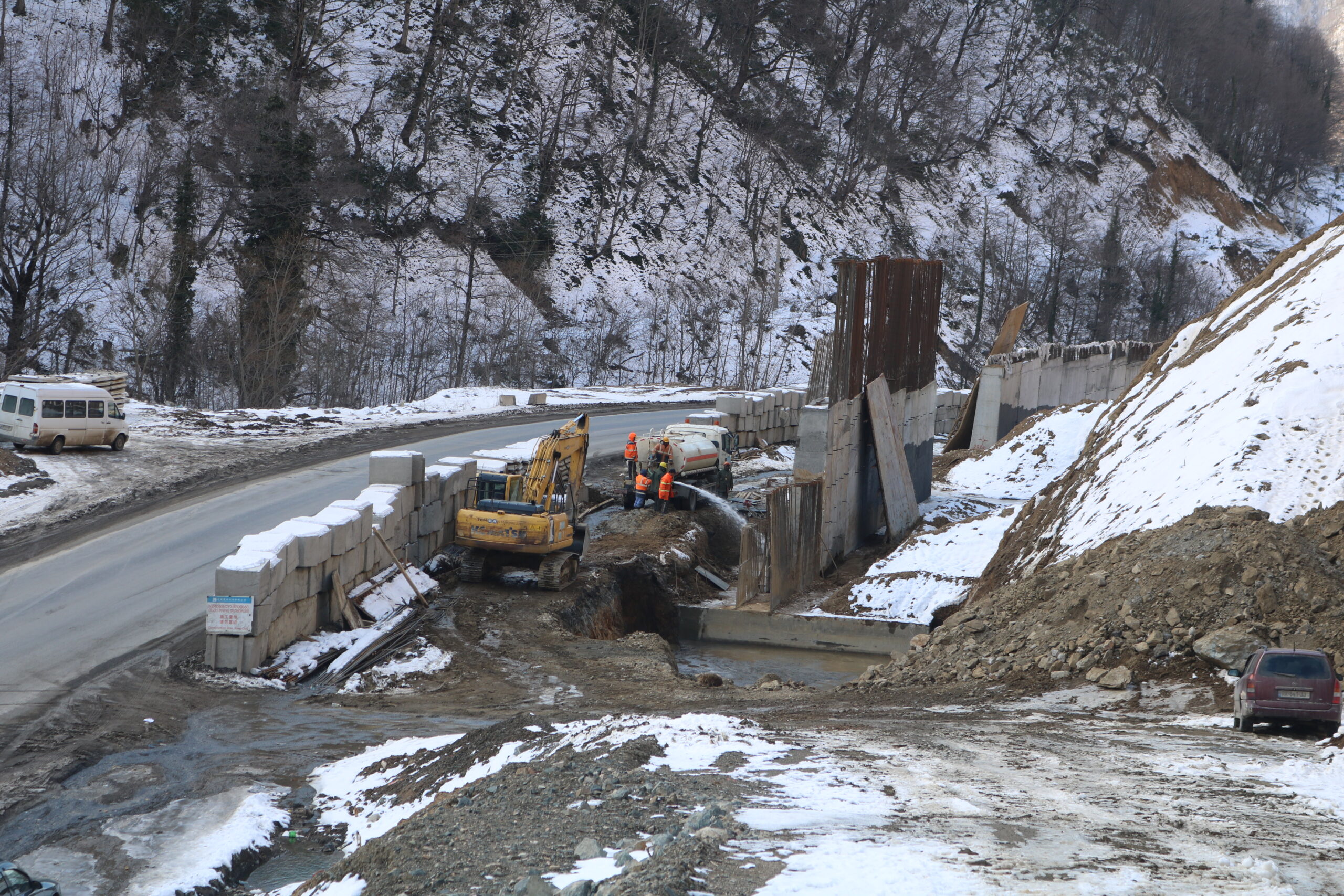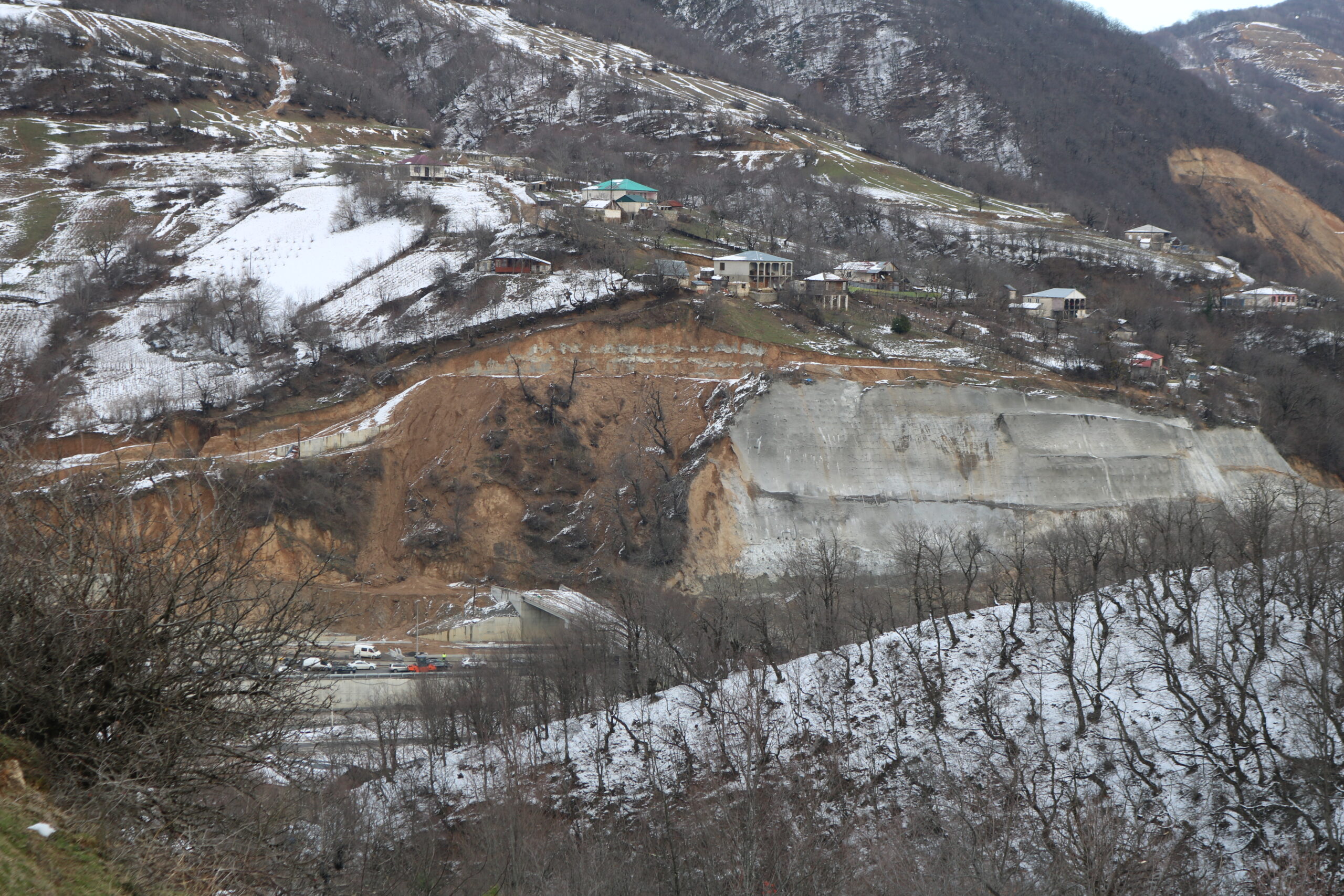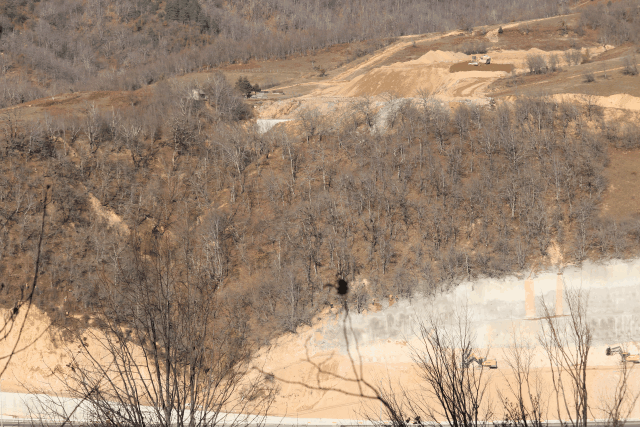The promise and perils of Georgia’s East–West Highway project
by Mariam Patsatsia (CEE Bankwatch Network and Green Alternative)
Khevi, a village cradled by the slopes of the Likhi Range, lies 140 kilometres west of Tbilisi. Reaching this rural community from Georgia’s capital involves driving along the dangerous and as-yet unfinished Rikoti section of the East–West Highway. The route is punctuated by enormous bridges, soon to join the highway, and dark hollows where the entryways and exits of unfinished tunnels disappear into the vibrant green countryside. On the left, machines whir and men labour to advance the construction and secure slopes, destabilised by their own actions, where traces of frequent landslides still remain visible. To the right, piles of soil – the fallout from tunnel drilling and landslides – clutter and confine the Rikotula river, which runs for 12 kilometres almost entirely parallel to the road.
Upon reaching the centre of the village, it becomes clear that every corner of Khevi holds both visible and unseen threats.

The East–West Highway: The fallout from the ‘project of the century’
The East–West highway links the nation’s eastern regions to its western territories, as well as to the Black Sea coast. Integral to the E60 European Transit Road, the highway serves as a crucial link for transit between Europe and Asia and provides an opportunity for enhanced trade and investment. The highway’s most intricate section traverses the rugged and narrow Rikoti Pass, navigating through delicate, mountainous terrain. This particular portion, known within Georgia as the Rikoti Road, extends over 50 kilometres. Its construction has been divided into four distinct sections. Each segment has been conceived as an individual project, complete with its own environmental impact assessment. Three international donors – the Asian Development Bank (ADB), the World Bank (WB), and the European Investment Bank (EIB) – took over financing, with construction passed on to several Chinese companies. The highway construction carries a hefty and growing price tag of approximately GEL 3 billion (EUR 1 billion) and, after years of delay, is now scheduled to be completed at the end of 2024.
| Sections | Name | Length | Funding | Construction Company |
| F1 | Chumateleti–Khevi | 11.7 km | EIB, WB | China State Construction Engineering Corporation Limited |
| F2 | Khevi–Ubisa | 12.2 km | ADB | Hunan Road and Bridge Construction Group |
| F3 | Ubisa–Shorapani | 13 km | EIB | China Road and Bridge Corporation |
| F4 | Shorapani–Argveta | 14.7 km | ADB | Guizhou Highway Engineering Group & China National Technical Import and Export Corporation |
For years, commuters have dreaded the Rikoti Road due to frequent traffic jams and accidents. So, when the government announced construction works, including the building of 97 bridges and 51 tunnels to straighten the winding road, the news was met with anticipation for its promised benefits: doubling the highway’s capacity and increasing travel speed, which would significantly reduce journey times across the country. ‘It is indeed the project of the century’, former Prime Minister Irakli Garibashvili remarked in 2021 during one of his visits to the construction site. He had said it before, and he would repeat it many times thereafter.
But the construction project, once heralded as a symbol of progress and splendour, has been marred by controversies. And public perception has shifted dramatically, as frequent landslides, accompanying road closures, and the collapse of newly built structures (further to the west, but part of the highway) have led people to regard the praised linear infrastructure as a potential danger to their safety and well-being. ‘It’s a scary sight when you’re in the car with the whole family and your child. It affected me emotionally’, Keti Labadze, a commuter who witnessed the landslide on the Rikoti Road last December, told reporters. The mass of soil was not big enough to overrun the barriers that road authorities had erected against landslides, and her family left the scene unscathed. But slowly, with each rainfall, the barriers are being filled with the soil that continues to cascade down from the slopes.

Experts have observed that the landslides have intensified since construction works on the Rikoti Pass began, disturbing the delicate balance of the vulnerable and unstable slopes in the Rikoti Pass. Critics have also questioned the quality of the environmental impact assessments, particularly why safer and more cost-effective alternative routes, which would have bypassed the landslide-prone areas by widening the old existing road, were not selected.
Questions have also swarmed around the role of poor-quality construction practices employed by the constellation of Chinese state-owned firms in the overall environmental and social impact of the project and how the winning contracts were awarded to companies with murky backgrounds and histories of serious misconduct and corrupt practices.
Khevi: A community in rough waters
‘At first, they [the project authorities] came with such promises, we all thought we had struck gold’, one local woman from Khevi said, referring to the many vows the government and road authorities had made ahead of the highway’s construction. ‘But then all these landslides happened, and so many of them…’ her neighbour interjected to highlight the contrast between the early expectations and the ensuing reality.
In the village that lies at the intersection of two project construction segments – Chumateleti–Khevi and Khevi–Ubisa – landslides have slowly crept towards residential areas, posing physical risks to vulnerably located family homes. The World Bank’s Implementation Status and Results Report (ISRR), published in September 2023, revealed that 23 new complaints from the Chumateleti–Khevi section, the majority concerning the landslides that hit the region in April and May 2023, including three cases requesting physical resettlement, were lodged with the project’s grievance mechanism. By February 2024, at least one affected family that we spoke to was still waiting on a decision about their relocation. The latest ISRR, released in March 2024, does not provide updates on any of these cases or on any potential new developments and, rather ominously, the section has been entirely removed from the report.

Locals have also grown increasingly worried about the Rikotula, known for its floods and flash floods, which slices through the village and flows alongside the Khevi public school. The school, which currently also houses the village preschool, serves approximately 150 children from the local community, as well as from the nearby villages of Tsakva, Grigalati, and Nadaburi. The volatile river at the heart of the village is itself enough reason to worry, but the Khevi community has much more to be anxious about. The riverbed of the Rikotula has been narrowed at certain points by the deposition of inert waste from highway construction. This increases the risk of mudflows.
Complicating matters, the stretch of river adjacent to the school has been subject to artificial straightening and modification. According to estimates provided by hydrologist Nika Tsitelashvili, the maximum discharge of the Rikotula – that is, 100-year flood – at the school location exceeds 227 m3/sec. This water volume, is nearly 75 times higher than the multi annual average flow of the river which is just 3 m3/sec. He maintains this underscores the need for detailed studies and hydrological reports to determine the risk zone for the school and its surrounding area.
Tsitelashvili points out that the environmental impact assessment and hydrological reports lack current data and hydrological modelling. He emphasises that this information is essential for accurately determining flood zones and associated risks – crucial for decisions regarding the relocation of the school, the design of bridge structures, and the planning of waste disposal sites along the river. He also argues that with proper hydrological modelling, organising waste dump sites across nearly the entire length of the river would likely be ruled out as a viable option.
‘How can you feel safe here?!’
a grandmother of an eleven-year-old boy attending the Khevi school asked. And her sentiments are repeated by other parents and grandparents in the village.
A mother of two students also recounted that at the start of the academic year in early autumn 2023, the school administration penned a letter to the Ministry of Education to raise red flags following alterations to the river. The letter, according to her, was signed by nearly every parent. Despite this, she remains uncertain as to the results of this appeal.
But this is just one of Khevi’s many troubles. As the construction company could not dump all of the waste rock generated due to tunnel drilling and landslides into the riverbed and floodplain, they took it to a ravine that overlooks the highway, the village itself, and the river Rikotula. This ill-thought-out and botched arrangement of the waste-rock dump site in the ravine now threatens the settlement and its public school. The slopes of the ravine appear destabilised, and the functionality of the dam, constructed to anchor the disposed waste rock, is poor to non-existent.

The waste-rock dump site in Khevi is not designated as a waste disposal site in the project’s environmental impact assessment. In April 2021, the Roads Department obtained approval from the Ministry of Environment to relocate a waste-rock dump site from an area near the town of Khashuri to the riverside areas and ravine in Khevi. This environmental decision was informed only by a screening procedure. The World Bank and the EIB are financing the construction of the section where the waste site is located. However, the EIB stated in a 13 March email that it had not been formally informed of the site’s relocation by the project promoters, and had neither approved the change nor provided a non-objection to it. The World Bank has not responded to our questions on the matter.
Green Alternative has also reached out to national authorities in Georgia to address concerns about the dump site. Despite initially raising the issue on 26 December 2023 and making multiple follow-up attempts, the Environmental Monitoring Agency responded with a single letter on 6 March, following Green Alternative’s request to Public Defender to intervene. The agency confirmed that an investigation was underway but did not provide details on its scope or timeline, and has since provided no further updates.
Currently, the dump site is not in use. In January, landslides struck the area, impacting the access road and preventing trucks from reaching the location. The company subsequently found an alternative dump site approximately 15 kilometres to the west in the neighbouring village of Vertkvichala (the Khevi–Ubisa section, funded exclusively by the ADB).
The soil disposal site at this location is no less problematic. The environmental impact assessment of the Khevi–Ubisa section initially earmarked three potential locations for waste disposal. Two sites located to the north of the planned road were ruled out due to their complex natural features and significant environmental impacts, including extensive tree felling and challenges related to topography and hydrology.

However, in 2020, the Roads Department requested and received approval from the Ministry of Environment to situate a waste-rock dump site in the previously discarded location, again based solely on a screening procedure. The screening report submitted by the department did not acknowledge that the selected site had been previously dismissed in the EIA but emphasised the importance of taking measures against the flooding and inundation of the area, suggesting an acknowledgment of the environmental risks still associated with the site. No such measures were in fact implemented.
‘A huge amount of soil has been dumped into the river,’ said Professor Zurab Javakhishvili of Ilia State University, who visited the site with us on 9 April 2024. ‘After heavy rains, in the case of flash floods, this waste could just turn into mudflow.’
Waste site in Vertkvichala (drone footage: Zurab Javakhishvili | Green Alternative, 9 April 2024).
Unheard communities
Despite the community’s concerns regarding environmental damage and changes resulting from the highway construction, local residents have struggled to be heard. Although the Roads Department of the Ministry of Infrastructure, the project promoter, claims to have conducted 78 individual and group meetings along the 50-kilometre route in 2023, members of the Khevi community assert that communication with the department primarily occurs at their initiation and has yielded few, if any, improvements. And Khevi is not an isolated case; it reflects a broader narrative of communities struggling to be heard in the development process.
Across numerous villages, residents share eerily similar narratives of neglect and indifference to their concerns amid and following the construction process. Residents recount the suffocating clouds of dust that engulfed their homes and streets, a result of the construction companies’ refusal to dampen the sites with water – a practice they avoided either to protect their machinery or to maintain a faster work pace. Memories of sudden explosions that rocked the villages, often catching residents off guard and sometimes before any form of warning could reach them, are also vivid. Many allege structural damage to their homes due to blasts and vibrations from the construction. People speak of nights filled with the incessant noise of road headers drilling tunnels directly under their homes, disrupting their sleep and their peace at ungodly hours for months. Furthermore, they share the frustration of having their usual road connections cut off by the construction activities, forcing them to take much longer, more cumbersome routes just to reach their own homes or access essential services.
Residents have also found themselves silenced by the weight of the project’s declared importance, with the message that any discomfort must be endured for the nation’s greater good. Road authorities have swiftly framed criticisms and queries as opposition to the initiative in an attempt to undermine genuine concerns. Instead of responding to legitimate questions, the Georgian government has opted for emphasising the significant engagement of international donors and experts as a steadfast assurance of the project’s integrity and alignment with global standards. The government has lauded the highway as a monumental project, emblematic of progress and modernisation. Yet, in the absence of stringent oversight and meaningful measures to address the adverse environmental and social effects, what was hailed as a dream come true by the government risks becoming the nation’s nightmare.



